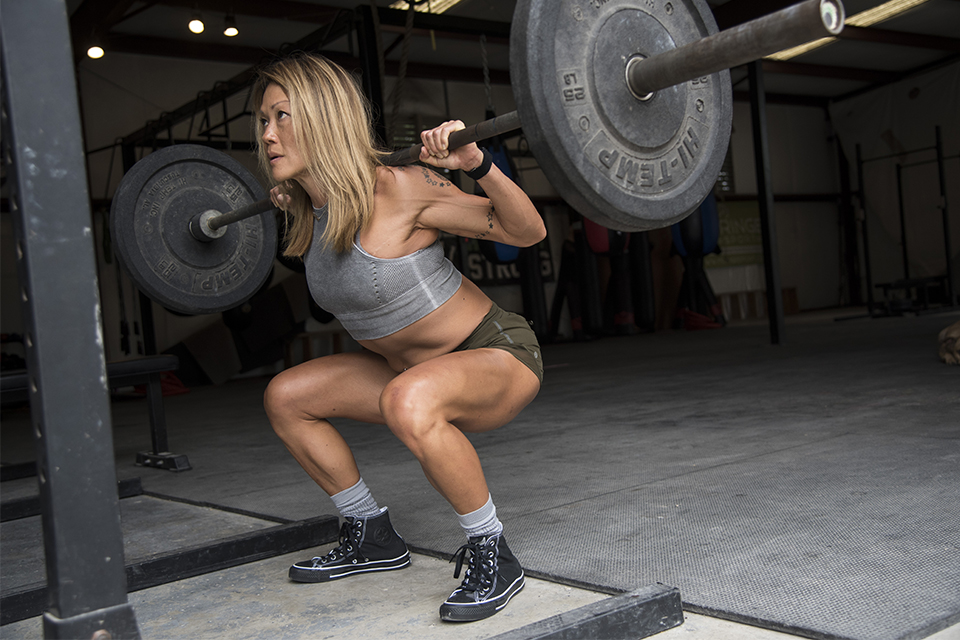Weightlifting Shoe-Ins

Olympic weightlifting and powerlifting can bring a wide array of benefits to your fitness regimen, but only if it’s done correctly. Trainers place a strong emphasis on proper form to prevent injury, but there’s an equally significant factor that is often overlooked (especially by those who are new to these disciplines). Your footwear can affect the mechanics of your squat, mobility, and balance—all of which play a role in your strength and safety.
Physical therapist Ben Shook, PT, DPT, COMT, weighs in on the risks and benefits of each option.
The Big Three
Converse Chuck Taylors
The simple design is surprisingly versatile and one of the most affordable workout shoes. The flat sole keeps your foot close to the ground, making it easier to exert your energy downward—a necessary component when lifting heavy weight.
Kathie Tam started out wearing lifters because they allowed her to squat deeper when she had ankle mobility issues. Once she improved her stability, she made the gradual transition to Chuck Taylors. “The flat sole keeps me close to the ground for all the three big lifts: squat, deadlift, and bench. I feel planted to the floor and they allow me to push through the ground and go straight up. I lace them all the way up to add ankle stability.”
The Doctor’s Prescription: They don't have much in the way of foot bed, but the laces up to the top can provide that little extra stability. If they are laced too tight then that can restrict normal motion of the ankle joint, increasing forces up to the knees and hips.
Weightlifting-Exclusive Shoes
There are a wide array of shoes made specifically for weightlifting, but the general appeal stems from a shoe's comfort, protection, and functionality. Lifters (shoes with a raised heel) make a difference in the way the squat feels and helps maintain an upright position. Meanwhile, shoes without a heel lift can offer the same ankle support as Converse—a desirably sturdy sole, but more comfort.
Dana Rygwelski, powerlifting coach at Austin Simply Fit, wears both kinds of shoes. For powerlifting, she prefers a flat shoe like the Reebok CrossFit Lite. “I can spread my toes out in the shoe to stabilize my balance and hold my weight midfoot, throughout the entire lift. Plus, the toe box on that shoe is a dream compared to Chucks,” she says. However, Rygwelski opts for a lifted shoe for Olympic style lifting and some Strongman events because it puts her in a more advantageous position for those particular movements.
The Doctor’s Prescription: The lifting shoes with lifters are good because they open up the ankle—they’re really nice for someone with stiff ankles. It will lighten the load off the knees, especially with squats, which require a fair amount of ankle mobility.
Barefoot
If you look at the human body, everything connects, and there's an action for every action—good or bad. And, speaking from a joint-by-joint approach, everything happens with the feet. Athletes have no way of compensating for weaknesses in the foot and ankle when they lift without shoes.
Sierra Nevels, who competes in powerlifting and Olympic weightlifting, prefers to use shoes for some lifts and keep them off for others. “The reason I choose to lift barefoot for powerlifting (specifically for the squat and deadlift) are because you're able to feel and grip the ground—especially with the big toe, which activates the gluteal muscles, but also builds the intrinsic muscles of the foot.”
Nevels also notes that any deficiencies in the foot could be indicative of a larger problem, and they’re easier to identify on bare feet.
“If you cannot press your big toe into the ground as you lift your other toes, there could potentially be a problem. Weak muscles in the foot—just like weak muscles anywhere else in the body—will cause and contribute to further injuries of the kinetic chain,” she says.
The Doctor’s Prescription: The benefits of being barefoot include having a better sense of where you are at in space. There is a lot of tactile feedback that the bottom of the feet provide to the nervous system.
The major risk would be dropping the weights on your feet. Also, hypermobile feet would have to work a lot harder in order to overcome the challenges of the movements themselves. If someone truly had hypermobility, then barefoot would not be ideal for them.






